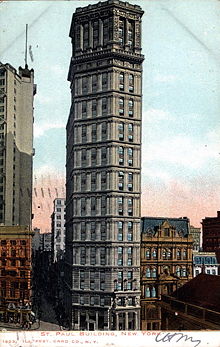
St. Paul Building
Encyclopedia

Skyscraper
A skyscraper is a tall, continuously habitable building of many stories, often designed for office and commercial use. There is no official definition or height above which a building may be classified as a skyscraper...
in New York City
New York City
New York is the most populous city in the United States and the center of the New York Metropolitan Area, one of the most populous metropolitan areas in the world. New York exerts a significant impact upon global commerce, finance, media, art, fashion, research, technology, education, and...
built in 1898 to designs by George B. Post
George B. Post
George Browne Post was an American architect trained in the Beaux-Arts tradition.-Biography:Post was a student of Richard Morris Hunt , but unlike many architects of his generation, he had previously received a degree in civil engineering...
that repeated the same Ionic order
Ionic order
The Ionic order forms one of the three orders or organizational systems of classical architecture, the other two canonic orders being the Doric and the Corinthian...
for each floor, to little cumulative effect. At 315 feet (96 m) it was one of the tallest skyscrapers of its era. The building was 26 stories tall. It was demolished without public expression of regret in 1958 in order to make way for the Western Electric
Western Electric
Western Electric Company was an American electrical engineering company, the manufacturing arm of AT&T from 1881 to 1995. It was the scene of a number of technological innovations and also some seminal developments in industrial management...
Building.
The building received its name from St. Paul's Chapel
St. Paul's Chapel
St. Paul's Chapel, is an Episcopal chapel located at 209 Broadway, between Fulton and Vesey Streets, in lower Manhattan in New York City. It is the oldest surviving church building in Manhattan.-History and architecture:...
which is located directly across Broadway
Broadway (New York City)
Broadway is a prominent avenue in New York City, United States, which runs through the full length of the borough of Manhattan and continues northward through the Bronx borough before terminating in Westchester County, New York. It is the oldest north–south main thoroughfare in the city, dating to...
from the tower's site in lower Manhattan
Lower Manhattan
Lower Manhattan is the southernmost part of the island of Manhattan, the main island and center of business and government of the City of New York...
.
Facade
A section of the ground-floor facade of the St. Paul Building, including atlantesAtlas (architecture)
In the classical European architectural tradition an atlas is a support sculpted in the form of a man, which may take the place of a column, a pier or a pilaster...
by Karl Bitter
Karl Bitter
Karl Theodore Francis Bitter was an Austrian-born United States sculptor best known for his architectural sculpture, memorials and residential work.- Life and career :...
, was removed when it was demolished and taken to Indianapolis, Indiana where it now stands in Holliday Park. It has been named The Ruins and also includes statues from other historic buildings. It was completed in 1977.

